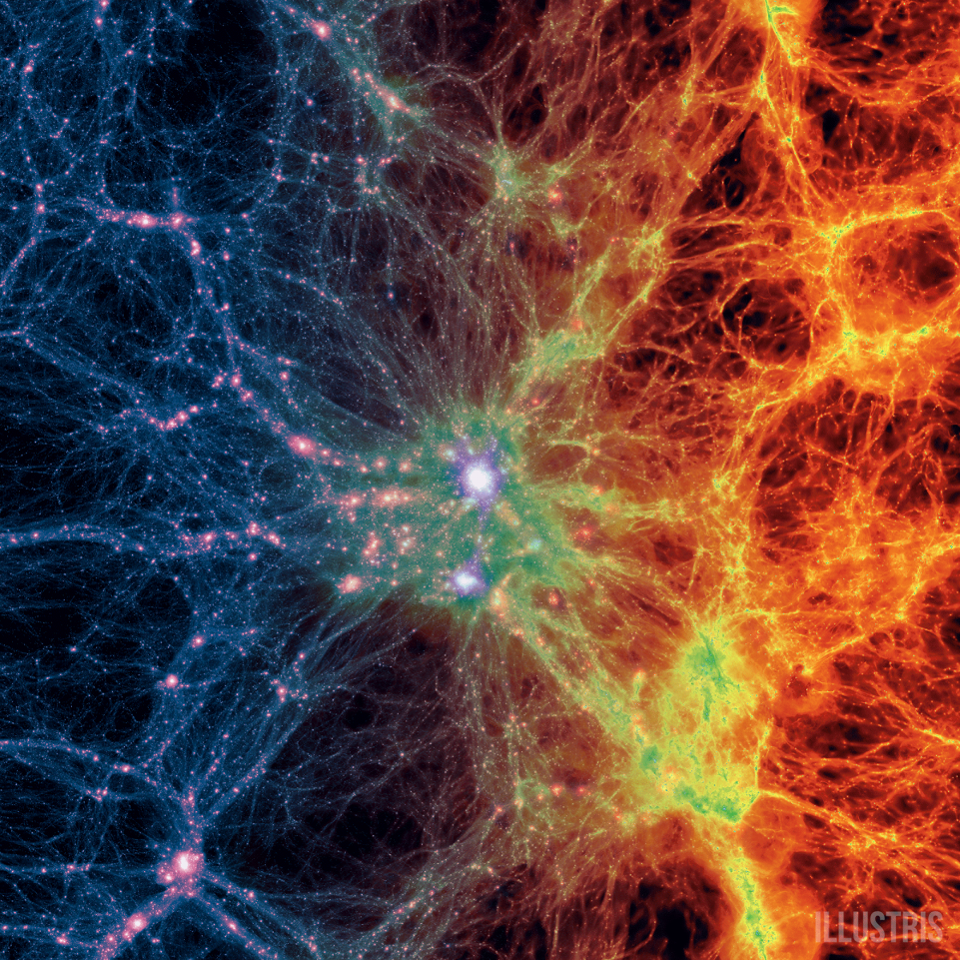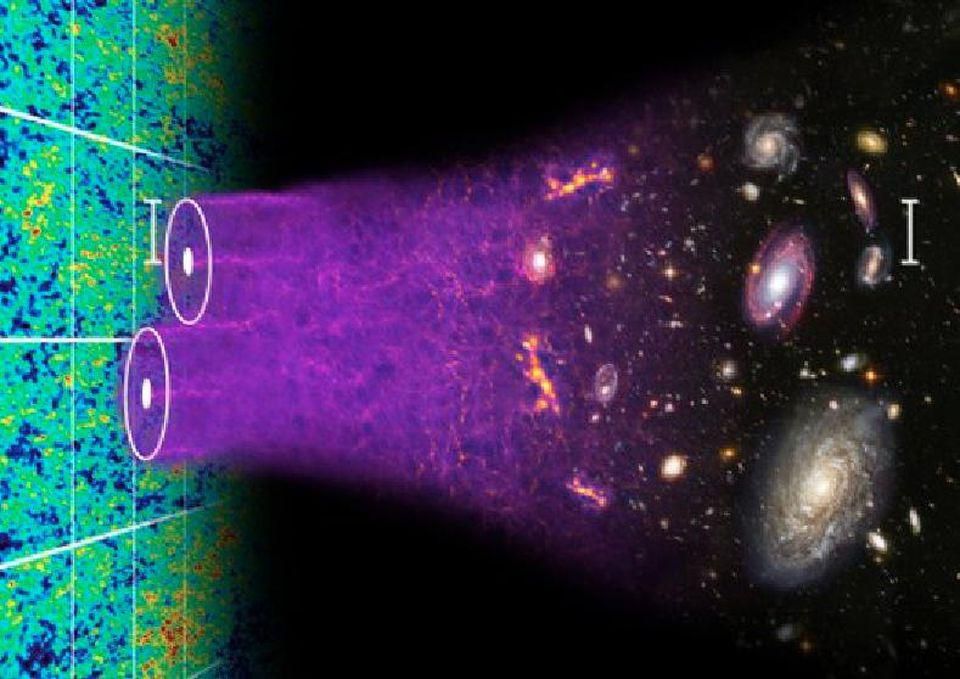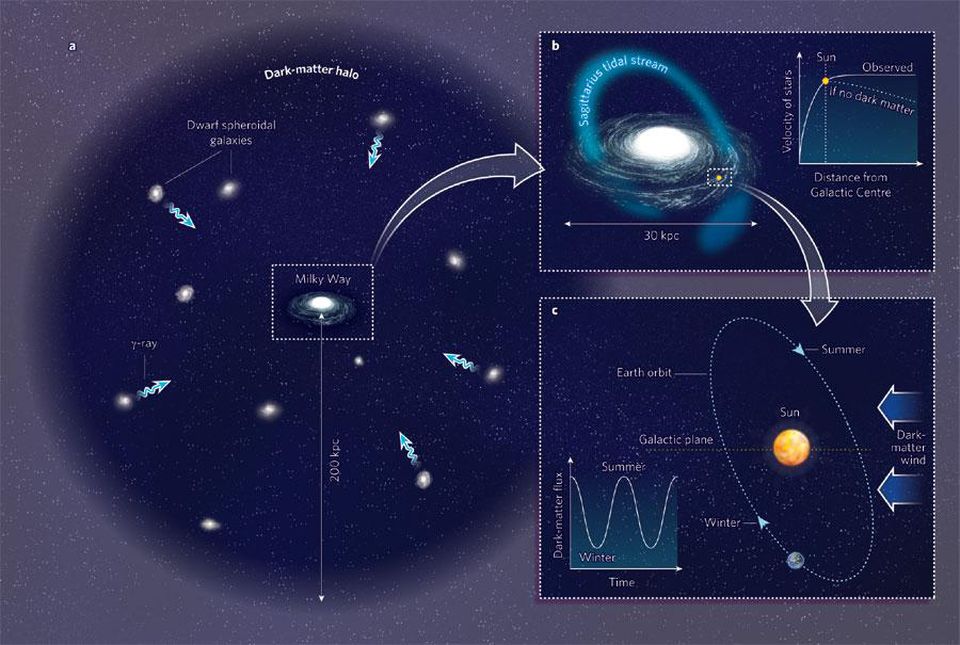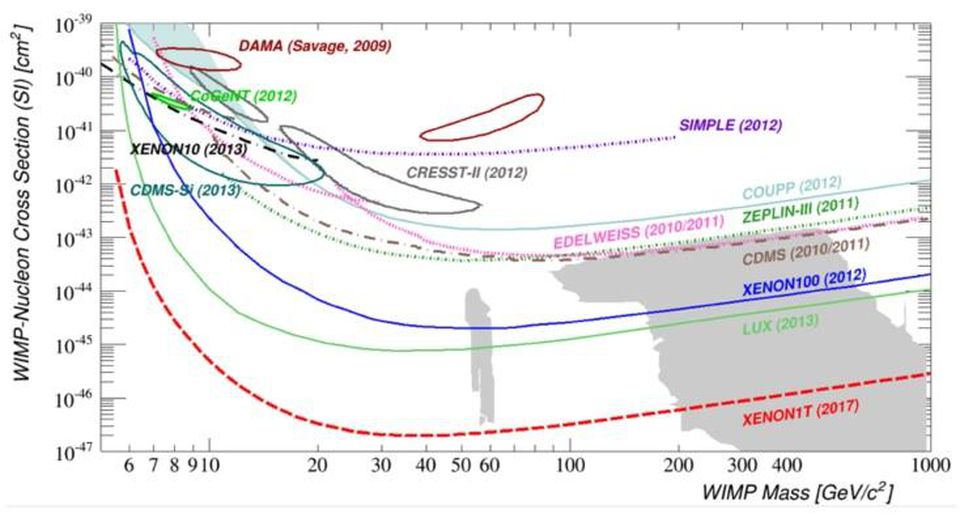How much dark matter passes through your body every second.
- Transfer

The formation of the cosmic structure on large and small scales strongly depends on the interaction of dark and normal matter. Despite indirect evidence of the existence of dark matter, we would very much like to directly detect it - and this can happen only if there is a non-zero mutual intersection between normal and dark matter.
The balance of matter in the universe, despite all its planets, stars, gas, dust, galaxies, and everything that we find in it does not converge. On the largest cosmic scale, we see the same thing: there is not enough matter for the gravitational effects we observe. Matter accumulates, forming a cosmic web; clusters of galaxies grow to enormous sizes, and inside them galaxies move at high speeds; individual galaxies rotate at high speed, remaining large to their very edge.
But all this could not be, if the matter was not five times more than everything, for which only protons, neutrons and electrons can be responsible. Our picture of the universe requires dark matter (TM) for internal consistency. And if it is real, then our Milky Way has its own halo of TM, with some of this TM passing through the solar system, the Earth, and even your body. And here's how to find out how much TM is inside you at the moment.

Dark matter is required to explain the observed phenomena in the Universe on the largest scales, from relic radiation to the cosmic web, clusters of galaxies and individual galaxies.
In the young universe everything was hotter, denser and more homogeneous than today. In earlier times, there were slightly denser areas that contained slightly more than average matter. Gravity attracts more matter to such areas, and radiation works to push it out.
If we had only normal matter and its constituent particles, together with this radiation, then galaxies and galactic clusters today would not be at all the ones we see. But if the TM is in the ratio of 5 to 1 with the usual one, we can theoretically reproduce the cosmic web corresponding to our observations and measurements.

On the largest scales, simulations (red) do not correspond to how galaxies actually accumulate (blue and purple), unless they include dark matter.
One of the consequences of the existence of TM is that any large structure that forms in the Universe, for example, a galaxy, will be surrounded by a large sparse halo of TM. Closer to the center of the galaxies, normal (atom-based) matter will gather, as it is able to collide and interact with itself and with radiation. But TM is just going through everything else: through itself, normal matter, photons, etc.
TM particles, interacting only through gravity, cannot lose a large initial impulse. In the entire history of the universe, each particle of TM could pass through the center of the galaxy no more than a dozen times.

According to the models and simulations, all galaxies should be shrouded in the halo of TM, whose density is maximum in the center. Even for quite long periods of time, billions of years long, each particle of TM on the edge of the halo barely completes one turn.
Dark matter dominates on the largest scales in the Universe. But where we are, in 25,000 light-years from the center of the Galaxy, ordinary matter locally dominates. On Earth, in the Solar System, the situation is even more different from the one that reigns in interstellar space. The density of the human body is comparable with water - 1000 kg / m 3 .
The density of dark matter where we live, even in the most realistic simulations, is many times less: 10 -12 kg / m 3. If you collect all the TM, located inside all people on Earth at a certain point in time, it will not be typed even on nanograms.

Earthquakes are known not only for cracks in the earth, but also for changes in the Earth's rotation, which, moreover, decreases slightly in diameter after the completion of a complete rotation. All this does not affect TM, nor does anything else that happens on Earth, including the presence or absence of people.
If you collect all the TM from the entire Solar System up to the orbit of Neptune, you will get no more than 10 17 kg: the mass of a small asteroid. However, since it does not interfere with normal matter, it does not move with the solar system. She is:
- does not rotate around the sun,
- does not move with the Sun and other stars around the galactic center,
- does not stay in the same plane
- does not rotate with the Milky Way disc.
In other words, relative to the Earth, it moves at a rather high speed under the influence of gravity!

The halo of TM around our Galaxy should show slightly different interaction properties when the Earth rotates around the Sun, changing our movement through TM in our Galaxy.
If you want to know how much TM passes through your body in a certain time, you only need to multiply four values. It:
- dark matter density
- human surface area through which TM passes,
- TM speed
- duration of time span.
Assessing the density of TM - and we already know it, it is 10 -21 kg / m 3 - we can immediately get an answer. Our galaxy is surrounded by a huge dispersed halo of TM, so its flow must go through our solar system. But in terms of density, it is quite small, which is why it is very difficult to detect. The surface area of a person is 1.7 m 2 . Since TM can come from a random angle, we can estimate the area crossed by TM about 0.6 m 2 . Our solar system is orbiting around the galactic center at a speed of about 200 km / s, but relative to TM this movement should go faster - closer to 350 km / s. This means that relative to the Earth TM moves at a speed of about 400 km / s.

And we can carry out calculations for any period of time - for every second, for a year, for a person's life (about 80 years).

Moving through the human body at a speed of about 400 km / s, each individual TM particle very slowly makes a revolution around the galaxy, in about a billion years. If there is any interaction between TM and normal matter, we will have a chance to detect it.
And if at any given time there are 10-22 kg of TM inside you , a much larger amount of it constantly passes through you.
- Every second about 2.5 × 10 -16 kg of dark matter will pass through your body .
- Every year - about 10 -8 kg.
- During life, about 1 milligram of TM will pass through a person.
At first glance, a tiny amount for a long period of time is collected in something tangible.

Hall B in LNGS with a XENON installation with a detector located inside a large water shield. If TM intersects with normal matter, then the experiment will have a chance to directly detect TM, and your body will react with it.
The fact that the obtained values are not so great speaks not only about the contents of our body, but also about whether we can dream of finding TM. Whether it consists of particles of very small or very large mass, at least, we know which mass of TM passes not only through a person, but also through any detector of a given volume. If we assume that we know the mass of the TM, we can calculate the number of particles passing through anything.
For several decades we have been building ever larger and more sensitive detectors, trying to probe possible elusive interactions between TM and ordinary matter. The most advanced detectors of today use atoms with a large nucleus and a large mass, and are looking for signs of rebounds or other interactions. And so far, all direct detection schemes for TM have yielded nothing. Restrictions on the intersection of dark matter and rebound properties of the nucleus, including the predicted accuracy of the XENON1T design. All attempts made by us to find TM relied on a certain set of assumptions about the nature of TM, but the size of this mutual intersection is very limited.

Based on our best assumptions, TM is everywhere. It may not be visible to the eyes, but we can sense its gravitational pull. It passes through all the matter of the Universe, including people, as if there is nothing there. As far as we know, no collisions or interactions occur with it, except the curvature of space-time under its influence. It does not crumple, does not cluster, does not form structures like dark atoms or molecules.
And yet, if there is the slightest hint of the possibility of a TM colliding with normal matter or radiation, we can detect it. If even one particle of TM collides with one proton or electron in your body, we will have a chance. It is difficult to ask for more when it comes to one of the deepest mysteries of the universe.
